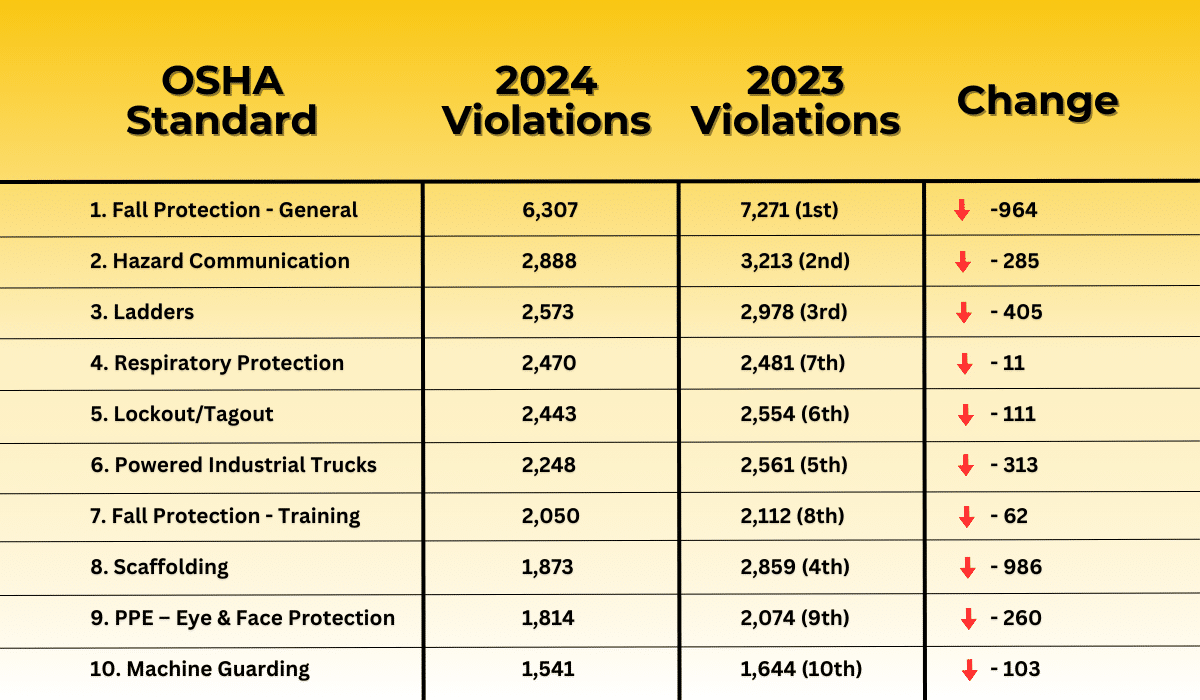Every fall, OSHA’s top 10 violations are released, in an effort to inform and educate employers on the most common issues in the workplace. This year’s annual list of the Top 10 Most Frequently Cited Standards for 2024 was released at the National Safety Council (NSC) Safety Congress & Expo. This list offers crucial insights into workplace safety trends.
Overall, 26,207 violations were totaled, a nearly 10% decrease in total violations compared to 2023, indicating slight improvements in compliance efforts across industries. As expected, Fall Protection – General Requirements maintains its longstanding position as the most cited violation for the 14th consecutive year. Following closely are Hazard Communication and Ladder violations.
However, one notable shift came from respiratory protection violations, moving up the list from 7th place into 4th.
This list serves as a guide for employers and safety professionals to enhance compliance and protect workers effectively.
Wondering which categories made OSHA’S top 10 violations for 2024? Let’s take a look.
Related Article: OSHA’s Top 10 Violations for 2023.
Related Article: 10 Reasons To Prioritize Workplace Respiratory Protection Programs in 2024

OSHA’s Top 10 Violations for 2024
The following are the most frequently cited OSHA standards for the fiscal year 2024, which runs from October 1, 2023, to September 5, 2024:
- Fall Protection—General Requirements (1926.501): 6,307 violations
- Hazard Communication (1910.1200): 2,888 violations
- Ladders (1926.1053): 2,573 violations
- Respiratory Protection (1910.134): 2,470 violations
- Lockout/Tagout (1910.147): 2,443 violations
- Powered Industrial Trucks (1910.178): 2,248 violations
- Fall Protection—Training Requirements (1926.503): 2,050 violations
- Scaffolding (1926.451): 1,873 violations
- Personal Protective Equipment—Eye and Face Protection (1926.102): 1,814 violations
- Machine Guarding (1910.212): 1,541 violations
Key Trends and Insights
The latest list shows familiar standards dominating the rankings, reflecting ongoing challenges in workplace safety:
– Consistency in Violations: Fall Protection remains the top violation for the fourteenth consecutive year, emphasizing its criticality in construction and other industries.
– Hazard Communication: continues to hold the second position for three years running, highlighting persistent issues with chemical safety and employee training.
– Respiratory Protection: has returned to fourth place (from seventh in 2023); after a drop in previous years, likely due to renewed focus on respiratory safety post-pandemic. This serves as a wakeup call for employers to pay more attention to protecting their workers from respiratory hazards, and to also keep up with OSHA standards for respiratory protection.
– The Lockout/Tagout: standard has seen a notable rise in citations, reflecting increased scrutiny on energy control procedures.
Importance of OSHA Standards Compliance
Understanding these citations is vital for employers aiming to improve workplace safety and compliance with OSHA regulations:
– Prioritize Safety Programs: Employers should review their safety programs against the Top 10 list to identify areas needing improvement.
– Engage Employees: Involving employees in safety discussions can yield valuable insights and foster a culture of safety within the organization.
– Training and Documentation: Regular training updates and thorough documentation are essential to ensure compliance with OSHA standards.
Strategies to Improve Your Overall Workplace Safety
To enhance workplace safety based on OSHA’s findings, consider implementing these strategies:
- Conduct Safety Audits: Regularly assess your workplace for hazards related to the Top 10 standards.
- Update Training Programs: Ensure that training programs are comprehensive and cover all relevant OSHA standards.
- Enhance Communication: Foster open communication about safety practices among employees to encourage reporting of potential hazards.
- Utilize Technology: Leverage safety management software to track compliance and manage safety data effectively.
What Can You do to Maintain the Respiratory Protection Standards?
Nearly every industry shares a common health danger to some extent: Airborne hazards are everywhere!
From silica dust to asbestos and mold, there’s plenty of risk to go around. And, if your team doesn’t feel safe within the environment, or they’re not trained to understand the toxins, it could cause lifelong lung issues. The question then becomes: Is that risk worth it?
From your perspective as an employer, you’ll also have to answer a question: Is it worth cutting corners on respiratory protection to save a few bucks now, even with the risk of OSHA fines and possible lawsuits?
To maintain a safe workplace, and to comply with OSHA’s respiratory standard, you need to develop, maintain, and implement a respiratory protection program for your employees. Including this topic in your safety program and health and safety manual is critical if any respiratory risk exists in your worksite.
Additionally, respirators give employees the confidence and protection they need to stay safe from dangerous vapors, dusts, smokes, mists, fogs, gasses, fumes, and sprays, and other airborne hazards.
Of course, you’ll need to ensure that your team is medically able to wear them, that they’re fit tested and clean, and that you’re retesting each year, as required.
Also, make sure to download your free Worksite Medical respirator refresher guide here. Feel free to print it and place it in a common area, so that your team understands respirator safety.
As for the fit testing, medical evaluations, and even blood testing? We can help with that, and no one even has to leave your jobsite.
Schedule your on-site medical surveillance testing today, or your customized quote, by completing the form below. Let’s make sure that we keep you off of next year’s OSHA’s top 10 list!
Key Takeaways
The OSHA Top 10 Most Frequently Cited Standards list serves as an essential tool for employers striving to enhance workplace safety and compliance.
By focusing on these key areas and implementing proactive measures, organizations can significantly reduce risks and create safer work environments for their employees.
For more detailed guidance on each standard and compliance strategies, employers are encouraged to explore resources available through OSHA or consult with safety professionals to ensure their practices align with current regulations.
About Worksite Medical
In most cases, OSHA requires medical surveillance testing, and at no cost to employees.
Worksite Medical makes that program easier with mobile medical testing.
We conduct on-site respirator fit tests, as well as audiometric exams, pulmonary function tests and heavy metal lab work, right on your job site. We also keep accurate, easy-to-access medical records for your convenience. You’ll keep your employees at work, and stay ahead of OSHA inspections.




